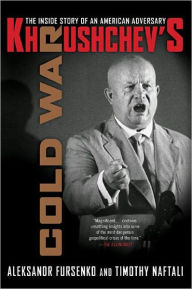Aleksandr Fursenko, one of Russia’s leading historians, is a member of the Russian Academy of Sciences.
Timothy Naftali, a frequent contributor to Slate and NPR, is director of the federal Richard Nixon Presidential Library and Museum. He lives in Los Angeles, California.
Khrushchev's Cold War: The Inside Story of an American Adversary
eBook
$11.99
$19.95
| Save 40%
-
ISBN-13:
9780393078336
- Publisher: Norton, W. W. & Company, Inc.
- Publication date: 10/25/2010
- Sold by: Barnes & Noble
- Format: eBook
- Pages: 640
- Sales rank: 409,134
- File size: 935 KB
Available on NOOK devices and apps
Want a NOOK? Explore Now
11.99
In Stock
“Contains unsettling insights into some of the most dangerous geopolitical crises of the time.”—The Economist
This acclaimed study from the authors of “One Hell of a Gamble” brings to life head-to-head confrontations between the Soviet premier Nikita Khrushchev and Presidents Eisenhower and Kennedy. Drawing on their unrivaled access to Politburo and KGB materials, Aleksandr Fursenko and Timothy Naftali combine new insights into the Cuban missile crisis as well as startling narratives of the contests for Suez, Iraq, Berlin, and Southeast Asia, with vivid portraits of leaders who challenged Moscow and Washington. Khrushchev’s Cold War provides a gripping history of the crisis years of the Cold War.Recently Viewed
Mark Atwood Lawrence
With their deeply researched Khrushchev's Cold War, Aleksandr Fursenko and Timothy Naftali lift the veil of secrecy further than ever, exposing how Moscow made foreign policy decisions during Nikita Khrushchev's tempestuous reign as leader of the Soviet Union from 1955 to 1964. The book is indispensable for anyone hoping to understand the cold war's most dangerous phase, and how the world managed to survive it.—The New York Times
Publishers Weekly
In the crowded field of Cold War historiography, Fursenko and Naftali continue to unearth valuable gems from newly available Soviet government documents, a portion of which were first put to use in their history of the 1962 U.S.-Soviet standoff over Cuba (One Hell of a Gamble). Building on increased access to such material, they develop a fascinating picture of the inner dynamics of the Soviet state and its leadership during the Khrushchev era that far surpasses anything U.S. intelligence could manage at the time. They make a convincing case that Khrushchev's major, post-Stalin reorientation of Soviet foreign policy was rooted in competition on the global playing field (and a policy of social regeneration at home), along with a need to cloak the U.S.S.R.'s weaknesses in arms and resources vis- -vis the U.S. This volatile combination reinforces a strategy of bluffs and brinkmanship in several Cold War crises between 1956 and 1962-in the Middle East, Central Europe and the Caribbean. Yet perhaps most surprisingly, Khrushchev's foreign policy-despite an energy that, when unchecked, "tended toward recklessness"-came with a genuine desire for peaceful coexistence between the superpowers not seen again until Gorbachev. (Oct.) Copyright 2006 Reed Business Information.
Library Journal
Fursenko (Russian Academy of Sciences) and Naftali (Univ. of Virginia) go beyond their top-flight "One Hell of a Gamble," an account of the Cuban missile crisis. Copyright 2006 Reed Business Information.
Kirkus Reviews
A Strangelovian paradox: The only way to preserve peace is to court war. So believed Soviet premier Nikita Khrushchev, who combined political cunning and a remarkable survival instinct with a sad awareness that "the Soviet position in the superpower struggle was so weak that Moscow had no choice but to try to set the pace of international politics." Confronted with five major crises-Egypt's seizure of the Suez Canal and subsequent intervention by France and England, a coup in Iraq, the Cuban missile showdown and workers' uprisings in Hungary, East Germany and Poland-that threatened to turn the Cold War hot in an instant, Khrushchev refused to cede ground until he was certain the Soviet position had been clearly understood. The West paid attention-perhaps too much attention. Thus, write historians Fursenko and Naftali (who previously collaborated on a book about the Cuban Missile crisis, One Hell of a Gamble, 1997), Khrushchev was able to mislead the opposition; for instance, he realized early on that Washington overestimated the Soviet's nuclear capability, especially its nuclear attack force, which was minimal, since the USSR lacked aircraft carriers, midair refueling capabilities and even the necessary long-range rocketry. Thanks to Khrushchev's skills, the U.S. and its allies spent untold amounts of money on things military, which the Soviet leader hoped would bankrupt them. But, as it happens, Khrushchev had to fight many battles back home; though his spirited shoe-banging helped prevent the outbreak of nuclear conflict, his critics at home "blamed Khrushchev for taking Moscow unnecessarily to the brink of war in 1956," and even closer to that brink in Cuba in 1962. Working withrecently released Soviet documents, the authors offer a nuanced picture of the Soviet leader and of a time marked by fear and plenty of pettiness (as when Khrushchev, touring the U.S., was refused admission to Disneyland). Sobering-even scary-and necessary reading for historians of the modern era.

